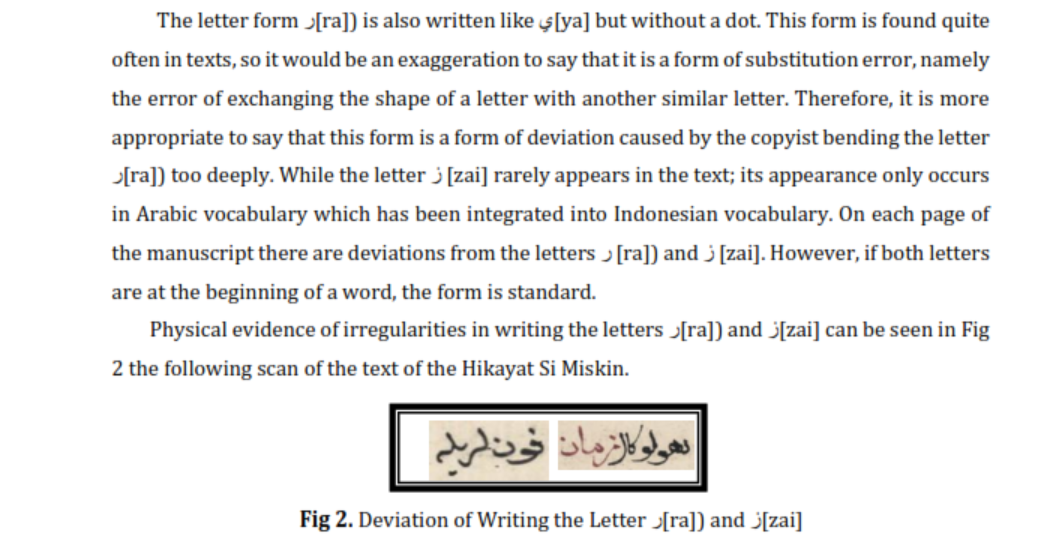A text criticism of Hikayat Si Miskin: A textological study of writing and use of letters
DOI:
https://doi.org/10.26555/bs.v43i2.556Keywords:
Text criticism, Textology, Corrupted script, Edition, Standard criticismAbstract
This research aim to describe a textological study of the issue of how the Hikayat Si Miskin manuscript text from the Harvad University - Houghton Library/ ms_Indo_18-METS collection was translated into handwritten Arabic-Malay script, the appearance of which is much different from the standard form of the letters of this script. This is the most important part in the textological study of the subfield of philology before the editing of texts from the old Malay Arabic-Malay script into Latin script is presented. His identity as the author is not included at the front of his work, but at the end of the manuscript called the colophon. The presentation of a text that has been cleaned of all writing errors paves the way for further study of the content of the text from various aspects related to the existence of the form and content of the text being studied, such as a study of the structural content of the text, a study of linguistic aspects, a study of social values. and culture, it is even possible to examine historical elements, because manuscripts are historical documents that describe the life systems and patterns of old society. The method used to discuss text issues and content that can be studied in various related scientific disciplines is the standard text criticism method, namely a philological method that attempts to re-present classical texts by criticizing and correcting corrupt texts. In accordance with the focus of the discussion which focuses on writing and visual text writing, the research results found writing irregularities and errors in writing lacunae, substitutions, additions, transpositions, dittography, and haplography. The most common writing errors are substitution errors.
References
Alwi, H. et al. (2003). Kamus besar bahasa Indonesia. Balai Pustaka.
Aisyah, S. (2021). Amalan tasawuf bidayatussalikiin dan aneka macam senjata (Suntingan teks dan kandungan isi). Khazanah: Jurnal Sejarah dan Kebudayaan Islam, 11(1). https://doi.org/10.15548/khazanah.v11i1.520
Aminuddin, H. (2021). Ketika pangeran minta jabatan: Kajian filologis terhadap sepucuk surat untuk Raffles (1811). Jumantara: Jurnal Manuskrip Nusantara, 12(2). https://doi.org/10.37014/jumantara.v12i2.1248
Baried, Baroroh, S. et al. (1985). Pengantar teori filologi. Pusat Pembinaan dan Pengembangan Bahasa.
Bustamam, R. (2017). Eksplorasi dan digitalisasi manuskrip keagamaan: Pengalaman di Minangkabau. Jurnal Lektur Keagamaan, 15(2), 446–469. https://doi.org/10.31291/jlk.v15i2.532
Fathurahman, O. (2015). Filologi Indonesia teori dan metode. Prenadamedia Group.
Hollander, J. J., de. (1984). Pedoman bahasa dan sastra Melayu (Terjemahan T.W. Kamil dari Handsleidingbij de Beoefing der Malaische, Tahun 1893, Edisi ke-6). Balai Pustaka.
Hayunira, S., & Supriatna, A. (2020). Ajaran tarekat qadiriyyah dan naqsabandiyyah dalam naskah"Tarekat" koleksi Museum Geusan Ulun Sumedang. Jurnal Lektur Keagamaan, 18(1), 223–249. https://doi.org/10.31291/jlk.v18i1.612
Hidayani, F. (2019). Kajian filologis naskah Layang Cariyos Samud Kagungan Keraton Kacirebonan. Indonesian Journal of Arabic Studies, 1(1), 90. https://doi.org/10.24235/ijas.v1i1.4921
Hidayatullah, D. (2020). Naskah Mantra Pengobatan: Suntingan, kritik, dan edisi teks (Manuscript of Medication Mantra: Editing, criticism. Kandai, 16(1), 44–62. https://doi.org/10.26499/jk.v16i1.985
Lubis, N. (2001). Manuskrip, teks, dan metode penelitian filologi. Yayasan Media Alo Indonesia.
Mohd, H., & Yusoff, Z. M. (2022). [Study of the Malay manuscript in Islamic Studies At Universiti Sultan Zainal Abidin between reality and challenge] Kajian manuskrip sastera kitab di Universiti Sultan Zainal Abidin antara realiti dan cabaran. International Journal of Islamic Products and Malay Civilization, 1(2), 217–228.
Mu’jizah. (2006). Filologi. Universitas Terbuka.
Nurizzati. (2019). Ilmu filologi: Teori dan prosedur penelitiannya. IRDH.
Nurizzati et al. (2022). Characteristic of manuscript Salasilah Raja-Raja Minangkabau: A codicology study. Proceedings of the 5th International Conference on Language, Literature, and Education (ICLLE-5 2022).
Noh, W. N. F. W., Fauzi, N., & Yusoff, M. F. M. (2022). Penyakit kanser menurut teks manuskrip perubatan Melayu terpilih: Analisis terhadap simptom, bahan medika, dan kaedah rawatan. Jurnal Filologi Melayu.
Permana, R. S. M., Sumarlina, E. S. N., & Darsa, U. A. (2020). Konsep “Parigeuing” dalam konteks kepemimpinan dan komunikasi politik berdasarkan naskah Sunda kuno. Jurnal Kajian Komunikasi, 8(2), 253–264. https://doi.org/10.24198/jkk.v8i2.25671
Satria, O., & Rasidin, M. H. D. (2020). Tradisi tulis ulama kerinci: Manuskrip Islam peninggalan KH Muhammad Burkan Saleh. Jurnal Lektur Keagamaan, 18(2), 463–488.
Sidik, S. (2015). Mulḥaq fī Bayān Al-Fawā’id Al-Nāfi’ah fī Al-Jihād fī Sabīlillāh: Aktualisasi jihad dan purifikasi azimat. Manuskripta, 5(2), 327–347.
Susilowati, M., & Darmono, D. W. (2017). Suntingan teks Nur Muhammad dan kajian cerita. International Young Scholars Symposium of Humanities and Arts.
Yanda, D. P. (2018). Teks cerita si palalok: Kajian pemahaman nilai-nilai kehidupan melalui metode literasi kritis. Bahastra, 38(1), 20–28. https://doi.org/10.26555/bahastra.v38i1.7998
Zaedin, M. M. (2019). Kajian teks naskah Gandoang Wanasigra Sindangkasih Ciamis. Jurnal Tamaddun, 7(1). https://doi.org/10.24235/tamaddun.v7i1.4505
ZE, D. S. (2022). Naskah Ratap Tangis: Telaah bentuk dan struktur teks. Mlangun: Jurnal Ilmiah Kebahasaan dan Kesastraan, 19(2), 213–223.

Downloads
Published
Issue
Section
License
Copyright (c) 2023 Nurizzati Nurizzati, Hasanuddin WS, Zulfadhli, Novia Juita, Muhammad Ismail Nasution, Hanifah Yulia Sari

This work is licensed under a Creative Commons Attribution-ShareAlike 4.0 International License.

1.jpg)






